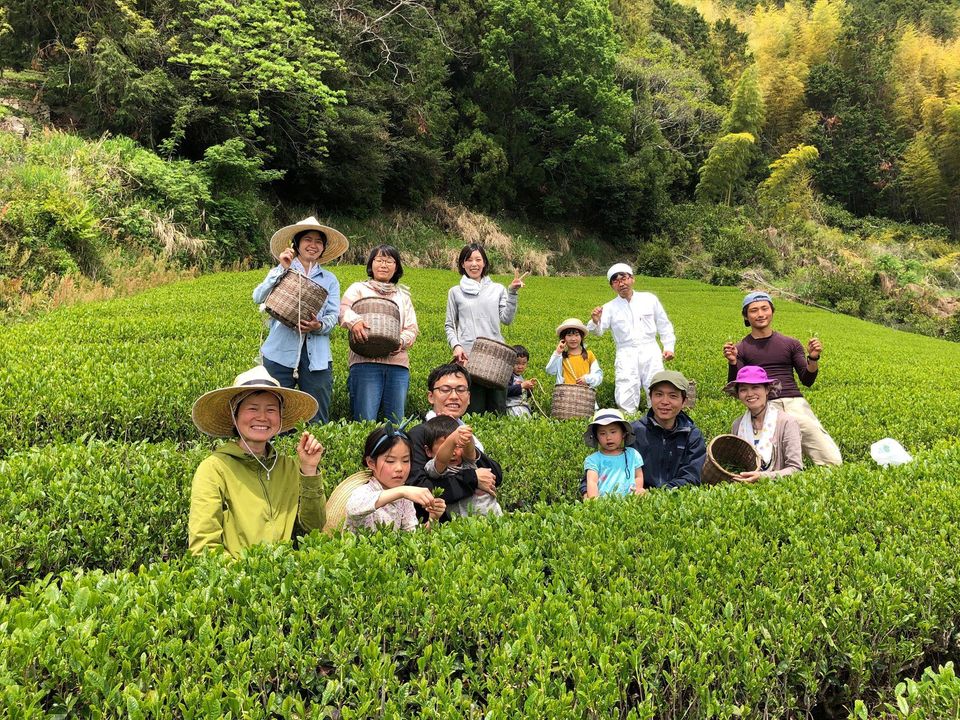あゆみファームズ・チットラット(杵塚あゆみ氏によって2019年に設立)は、現代の最も決定的な課題の一つ、すなわち持続可能な食料生産と、土地や人々との健全な関係をいかに両立させるかという課題に取り組んでいます。静岡県藤枝市の山間部に位置するこの小さなコミュニティは、有機農業、持続可能農業、再生型農業のシステムを構想し、実践するとともに、地域支援型農業(CCI)と地域支援型農業(CCI)を実践する独自の方法を模索しています。
あゆみファームズは、オーガニック、多様性、小規模という枠にとらわれず、アメリカや西欧の人々が「スローフード運動」に類似点を見出すかもしれないものを、日本独自の視点で実践する最新の農園の一つです。健全で革新的でありながら控えめな農法を支える理論的枠組みに基づき、現代の科学的知見と技術を、それぞれの地域の伝統的なシステムや老年農家の知識と融合させています。高品質な茶葉を持続的に生産するという彼らの使命は、農場と地域社会のレジリエンス(回復力)を高める実践によって補完されており、ますます過剰に適用されるオーガニックやサステナブルといったラベルを超えた方法論が用いられています。彼らは、アメリカ、ヨーロッパ、そして日本の新世代の農家が、どのようにこの課題に取り組んでいるかを示す好例です。 農業は地域社会が支援するものと、地域社会が支援するものがあります。
彼らの農業へのアプローチは、土壌から地域社会における栄養循環、そして人々同士、そして人々と彼らを支える土地との関係に至るまで、あらゆる関係性の再生と活性化を目指しています。この特別な2部構成のインタビューでは、杵塚あゆみさん(あゆみさん)に、お茶、土壌、そしてレジリエントなコミュニティの構築についてお話を伺うことができ、大変嬉しく思います。
- お茶愛好家のジミー・バーリッジ氏による序文
チットラットのアユミファーム設立のきっかけ
萌え: Yunomiサイトを見て、お父様の農園「 NaturaliTea (人と農、自然をつなぐ会)」にいらっしゃったことを拝見し、茶農家になろうと思ったきっかけを語る動画をいくつか拝見しました。あれから10年近く経ち、2019年に「あゆみファームズ チットラット」(Cyittorattu )を設立されましたが、独立を決意されたきっかけは何だったのでしょうか?
※この質問に対して、あゆみさんは、父親の代から農場や藤枝がどのように変わったかを尋ねるという私のその後の質問にも答えてくれました。
あゆみさん:そうですね、私たちは長年お茶農家を営んできました。独立を考え始めたのは、お茶農家を続けながら、同時に他の作物も育てたいと思った時でした。日本人の方なら、私が言っていることはよくご存知だと思いますが…ヨーロッパやアメリカと比べると、日本は山岳地帯が国土の大部分を占めているため、土地が限られています。そのため、広大な平地へのアクセスも限られています。そのため、日本で農業を行うということは、その土地ならではの方法で農業を行うことを意味します。日本では、欧米のように一つの作物を大規模に栽培することは理想的ではありません。100ヘクタール、1,000ヘクタールもの広大な土地で農業を行うことは不可能です。しかし、日本には日本独自の豊かさ、美しさがあります。四季があり、地形も非常に多様です。山と海の両方の恵みを受けています。私の農園は藤枝市の山間部にあります。
近年、日本では農地の集約化が進み、国を挙げて大規模生産が推進されています。こうした農業を行うには、大型機械が入りやすい平地が良いと考えられています。そのため、山間部の茶畑は残念ながら衰退傾向にあります。高齢化が進む中、私の周りの農家のほとんどは70代、80代です。実際、若い農家と言われる世代は60代で、私たちが知る20代、30代の若い世代は農業に全く興味がないという現状です。
このような背景を踏まえると、日本において単一作物、大規模栽培というアプローチで農業を発展させていくことは不可能だと考えています。そこで、日本における理想的な農業とは何かを自問自答した時、何世代も前の伝統的な農業のあり方を思いつきました。日本の農業は、単一作物を大量に栽培することに長けているわけではありません。しかし、様々な作物を小規模、少量ずつ栽培することに成功してきました。そして、特定の地域や生態系に適した作物を栽培することに成功しています。その意味で、私たちが拠点を置く静岡(藤枝)の山間部では、山頂で茶が栽培され、その麓の谷間に人々が暮らしています。そして、その限られた土地で、米や大豆も栽培されてきました。シイタケやクレメンタインといった他の作物、そして様々な野菜や農作物も栽培されてきました。茶は、栽培されていた数多くの作物の一つに過ぎなかったのです。
少し背景を説明すると、戦後、農家が「これらを使わなければ作物は育たない」と断言するほど、大量の化学肥料と農薬が使われた時代がありました。こうして日本の農業のあり方、農作業のあり方は大きく変化しました。しかし、日本には化学肥料や農薬に頼らない時代もありました。では、その時代、農家はどのようなことをしていたのでしょうか? 彼らは地域の生物多様性を守り、重視していました。そして、当時の農業は、農薬に頼らずとも、回復力のある作物を育てるというものでした。具体的には、茶樹に害を及ぼす害虫がいます。例えば、茶葉を食べたり、作物の栄養分を奪ったりする害虫。あるいは、茶樹を枯らしてしまう害虫…。害虫の種類は様々ですが、それらを食べる生き物もいます。クモやカマキリなどの昆虫、テントウムシ、小動物、鳥など、すべてが生態系の中で共存しています。ですから、特定の地域にこのような生物多様性があれば、害虫の発生は起こらないはずです。その地域で生物多様性が守られていれば、お茶もうまく育つはずです。私は、こうした農業のあり方を改めて考え直したいと思いました。生物多様性に加えて、作物の多様性も同様に重要です。農場で多様な作物を育てることで、農場自体と農場内の人間関係が豊かになると信じています。
私たちの農場では、米と大豆を栽培しており、パートナーは鶏も飼っています。稲刈りは10月末頃に終わりましたが、稲刈り後にはかなりの量の稲わらが残ります。この稲わらを茶畑に運び、茶畑の土の上にかぶせます。こうすることで、稲わらが土壌の乾燥を防ぐだけでなく、稲わらには多くの微生物が生息しているので、それらの微生物が土に戻り、土壌が豊かになります。この作業は、寒い冬にも効果的です。稲わらは毛布のような役割を果たし、土壌を暖かく保ってくれるからです。


稲刈り後の稲わらを茶畑に敷き詰める作業。決して簡単な作業ではありません!でも、あゆみさんは稲わらを茶畑に運ぶたびに、稲刈りを手伝ってくれた人たちのことを思い出し、心が温かくなるそうです。あゆみ農園では、たくさんの人の手と微生物をはじめとする生き物の力を借りて、お米やお茶を作っています。茶畑に敷かれた稲わらは、人の目には見えない数億、数百万もの微生物によって分解され、ゆっくりと土に栄養を戻していきます。循環の輪がずっと流れ続けているのです。
あゆみさん(続き):ご覧のとおり、化学肥料や農薬に頼る必要はまったくありません。これまでの知識を活用することで、私たち農家は農場内での循環を生み出すことができます。小麦も栽培しており、そこから得られる麦わらも堆肥として活用しています。また、鶏の糞尿は堆肥として活用しています。このように、農場内での循環を大切にしています。そして、これは今の時代にとても大切なことだと思っています。私たちの先代(つまり多くの農家)は、40年近く有機栽培の茶園経営をしてきました。しかし、地球を取り巻く状況は40年前とは大きく変わってきています。40年前は、農薬による汚染や化学肥料による地下水・表層水の汚染などが大きな懸念事項でした。日本では、レイチェル・カーソンの『沈黙の春』がベストセラーとなり、有吉佐和子の『複合汚染』もよく読まれました。そして、これが有機農業、無農薬農業などが流行した背景です。
それから40年が経ち、状況はさらに深刻化していると思います。地球温暖化、プラスチック汚染…そして日本では原発事故による汚染問題。そして、気づかないうちに少しずつ、私たちの日常生活に様々な悪影響が及んでいます。そして、残念ながら、農業自体が環境を悪化させる手段となってしまったのです。つまり、たとえ有機農業であっても、特定の作物だけを栽培する農家は、環境に負荷をかけていることになります。なぜなら、本来であれば生物多様性のバランスが取れている場所で、特定の作物だけを栽培することで、環境のバランスを崩しているからです。これは非常に不自然なことです。さらに、広大な地域で有機茶園を営むには、大量の有機肥料が必要です。これらの有機肥料の成分を見ると、多くのものが海外からの輸入品であることが分かります…そして最近では、「カーボンフットプリント」という言葉も広く使われるようになりました。 「有機農業」は、一見すると安全で環境に害を与えないように思えます。しかし、外部資源(例えば有機肥料)に頼る有機農業の持続可能性を考えると、特に10年、100年先を見据えると、その持続可能性は疑問視されるようになります。もしかしたら、環境へのダメージは大きくなっているかもしれません…。そして、農業の規模が大きくなればなるほど、大型の機械が必要になります。そういう意味で、私はこうした有機農業のあり方に疑問を持つようになりました。
小規模農業は非生産的だと言う人もいますが、私はそうは思いません。多様な作物を栽培することで、年間を通して収穫できます。そして、それらを販売することで、きちんと利益を上げることができます。また、小規模農業であれば、海外からの有機肥料などに頼る必要もありません。むしろ、地域内で容易に入手できる資源を活用し、その地域の土壌に還元することができます。こうしたアプローチは、はるかに持続可能だと私は考えています。そして、伝統的な農業のやり方を振り返ると、まさにそのようなやり方がとられていました。先ほども述べたように、米や小麦を栽培していたら、畑の稲わらや麦わらを使って他の作物を育てていました。大豆を栽培していたら、大豆の殻を使っていました。鶏を飼っていたら、その堆肥を使っていました。そして冬にはたくさんの落ち葉が落ちます。そこで、山でそれらの落ち葉を集めて、農作業に使っていたのです。このように、かつての農家は地域の資源を非常に大切にし、作物を育てていました。こうした農業が可能な範囲で、地域の資源を活用し、再生のサイクルに積極的に参加したいという思いが私の中に芽生えました。そして、私たちの農園で栽培しているお茶も、この方法で育てています。茶畑の間に稲わらを敷き詰め、大豆の殻も活用し、冬の間に葉を採取します。また、地域には酒蔵と伝統的な醤油蔵があるので、酒粕(お米を発酵させたもの)や醤油粕をいただくことができ、土壌の肥料として活用しています。これらは販売されていないため、私たちが受け取り、土壌に還元することができます。そして、これらの発酵肥料は、それ自体が微生物であるという素晴らしいものです。つまり、それらを土に還すだけでなく、土壌をより豊かにしてくれるのです。つまり、これこそ私がずっとやりたかった農作物の栽培、農業なのです。だからこそ、チットラットゥが設立され、私たちの農場では小規模ながらお茶をはじめとする様々な作物を栽培しています。すみません、長々と話していたので、質問の内容を忘れてしまいました…(笑)
萌え: 全然大丈夫ですよ!とても参考になり、貴重な情報ですね。お持ちの情報をすべて共有していただき、ありがとうございます。少し話を戻しますが、Cyittorattuを始めたのは2019年ですよね。でも、私の理解が正しければ、それ以前から稲作をされていたんですよね?何かの動画で拝見したような気がしますが…
あゆみさん:はい、そうです。ナチュラリファームズでも米と大豆を栽培していました。茶畑は2月から11月が繁忙期です。でも、その後の冬は比較的自由な時間が多いんです。だから、茶農家さんはこの時期に他の作物を育てたり、茶畑以外の場所で仕事をしたり、何かできることを見つけられるんです。この暇な時期に何かできないかと考えていた時に、昔から自分で味噌を作りたいと思っていたので、味噌作りを始めました。まずは原料の大豆と米麹を揃えて…
そのプロセスがとても興味深く、自分で原料を育ててみたいと思いました。そこで、藤枝地域には米作り農家の方がいて、米作り、麹作り、そして最後に大豆作りを学びました。私の世代の幸運な点は、これらの技術を教えてくれる上の世代がまだいるということです!私たちは地域や地域社会の年長者からこれらの技術を学びます。これは非常に重要なことです。なぜなら、日本はとても小さな国ですが、気候、条件、状況は場所によって大きく異なるからです。同じ作物を育てていても、時期は場所によって異なります。したがって、これらの技術を学ぶ最良の方法は、同じ地域の年長の農家から学ぶことです。彼らはまだ生きているので、私たちは彼らからこれらの技術を学ぶことができます。ですから、私は彼らから学ぶことができたことに感謝し、徐々に米、大豆、味噌作り、そしてクレメンタインを栽培し始めました。そして今、チットラットでは、確かに以前より自立しているかもしれませんが、私の仕事内容は基本的に変わっていません。私たちは基本的に、お茶を含む様々な作物を栽培しています。そして、それぞれの作物が互いに関係性を持ち、土壌を豊かに育むのです。それが私たちの基本的な仕事です。

チットラットにあるあゆみ農園での味噌作りの様子。 1年8ヶ月の熟成期間を経た味噌樽を開けたあゆみさんは、味噌と同じように、自分自身もうまく発酵・熟成できているのだろうかと自問自答した。
先人たちの知恵と知識の継承
Moé:わぁ、お話を聞いているだけでインスピレーションが湧いてくるような気がします…今のところ特に質問したり言ったりしたいことはないのですが、ただ聞いているだけで楽しいです。
あゆみさん: [笑い] ありがとうございます。でも、本当に、これらのことについて深く考えてきました。そして、どう前に進んでいくべきかずっと考えてきました。そして、私が最も懸念していることの一つは、日本の農家の皆さんが高齢化していることです。そして、若い世代は農家の皆さんの跡を継ぐことに興味を示さないのです。これは非常に残念なことであり、また恐ろしいことです。先ほども申し上げましたが、農家の皆さんはこうした知識を本などに書き留めたりしないので、人から人へとしか伝承できません。ですから、年配の農家の皆さんが亡くなると、彼らが持つ知恵や知識も失われてしまうのです。だからこそ、若い世代がどのようにしてこうした知識を継承していくことができるのか、私は本当に心配しているのです。
私が茶業の継承に努めてきたことの一つが、茶葉の手摘みです。私の祖母の世代(今は亡き)は、4、5歳という幼い頃から茶葉の手摘みを始めました。今では70代、80代の茶農家の方々にもその手摘みを目にすることができます。彼らは茶葉を手摘みする技術も非常に高く、しかも非常に速いので、本当に驚かされます。茶葉の手摘みは、芽を摘むだけでなく、丁寧に摘むこと、そしてどれだけ摘めるかが重要で、本当に大変な作業です。ですから、これは練習と反復練習にかかっています。残念ながら、日本では茶葉の手摘みが失われつつあります。そんな状況の中、私は友人や周りの人たちを誘って、一番茶の時期や紅茶用の茶葉を収穫する時期に、茶葉の手摘みを体験してもらっています。もちろん、一度体験しただけでは茶摘みはなかなか上手くなりませんし、体も覚えません…。でも、友人の中には何度も参加して、少しずつ技術やリズムを掴み始めている人もいます。30人集まって茶摘みをしても、1日で取れる量は30kgくらい。ベテランのおばあちゃんなら1人で10~15kgは取れるそうです。もちろん、私たちが先人たちの技術に近づくことは決してありませんが、毎年このような体験をすることで、こうした技術や経験を後世に伝えていきたいと思っています。

地域住民とともに第2回目の茶摘みをしました。遠近から20名の参加者が集まり、朝8時から夕方まで収穫を手伝い、20kgの茶葉を集めて手摘み紅茶を作りました。
残念ながら、手摘みの茶葉生産では、大勢の従業員を雇わなければ利益は出ませんし、コストもかかります…。以前は、手摘みした茶葉を引き取って加工する小さな製茶工場がたくさんありました。しかし、今ではそうした小さな製茶工場さえも姿を消しつつあります。また、大量生産に対応した製茶設備の現状では、手摘み茶の生産・加工はさらに困難になっています。幸いにも、私たちの知り合いに80歳を過ぎたおじいちゃんがいて、今も手摘み茶の加工を続けています。そこで私たちの手摘み茶を加工しています。こうして、お茶の一部ではありますが、地域の皆さんやイベントに参加してくださる方々のご協力を得て、手摘み茶の生産を続けています。紅茶の一部も手摘み茶を生産しています。
 年配の整備士が営む小さな工場では、年代物の製茶機械を整備している。近年の工場では120kg、240kgと茶葉を扱うところもあるが、ここは30kgラインの機械が並ぶ。小さな工場だからこそ、少量しか生産できない手摘み茶や山茶などにも対応できるのが強みだ。また、最近の工場は自動化が進み、スイッチ一つで茶葉が機械から機械へと流れるようになっているが、この小さな工場では、一つ一つの工程、次の工程に移るタイミングなど、すべて人の手と感覚が関わっている。
年配の整備士が営む小さな工場では、年代物の製茶機械を整備している。近年の工場では120kg、240kgと茶葉を扱うところもあるが、ここは30kgラインの機械が並ぶ。小さな工場だからこそ、少量しか生産できない手摘み茶や山茶などにも対応できるのが強みだ。また、最近の工場は自動化が進み、スイッチ一つで茶葉が機械から機械へと流れるようになっているが、この小さな工場では、一つ一つの工程、次の工程に移るタイミングなど、すべて人の手と感覚が関わっている。
Cyittorattuの意味 - 少しずつ
あゆみさん:言い忘れていましたが、「ちぃっとらっつ」というのは静岡県藤枝地方の方言で、「少しずつ」という意味です。ですから、私たちが「ちぃっとらっつ」だからこそできる、少しずつのお茶づくり。効率化や大量生産を重視する現代の考え方とは、ある意味相反する部分があるかもしれません。でも、現代のやり方では忘れられ、失われているものがあると信じています。だからこそ、この伝統的な、少しずつのお茶づくりに価値を見出していきたいと思っています。
Moé:はい、Cyittorattuですね…Yunomiであなたの農園のコレクションページを準備していた時、イアンさんが「あゆみファーム」という名前にしようと言っていて、アルファベットだとちょっと難しそうなので「Cyittorattu」を最後に付けようかと提案してくれたんです。でも、あなたのサイトで「Cyittorattu」の説明を読んで、「Cyittorattu」は必須だと思いました。それに、日本の方言って本当に好きなので、「Cyittorattu」の部分は残しておいてよかったです!
杵塚あゆみさんへのインタビューは、次のブログ記事で続きます。地球温暖化が農業に及ぼす影響や、農業と未来の農業へのビジョンについて、あゆみさんからさらに詳しくお聞きいただけますので、Yunomiをぜひご覧ください。また、あゆみファームズとCyittorattuについてもっと知りたい方は、Yunomiのコレクションページをご覧ください。
バナー画像クレジット: Ayumi Farms、Cyittorattu。


